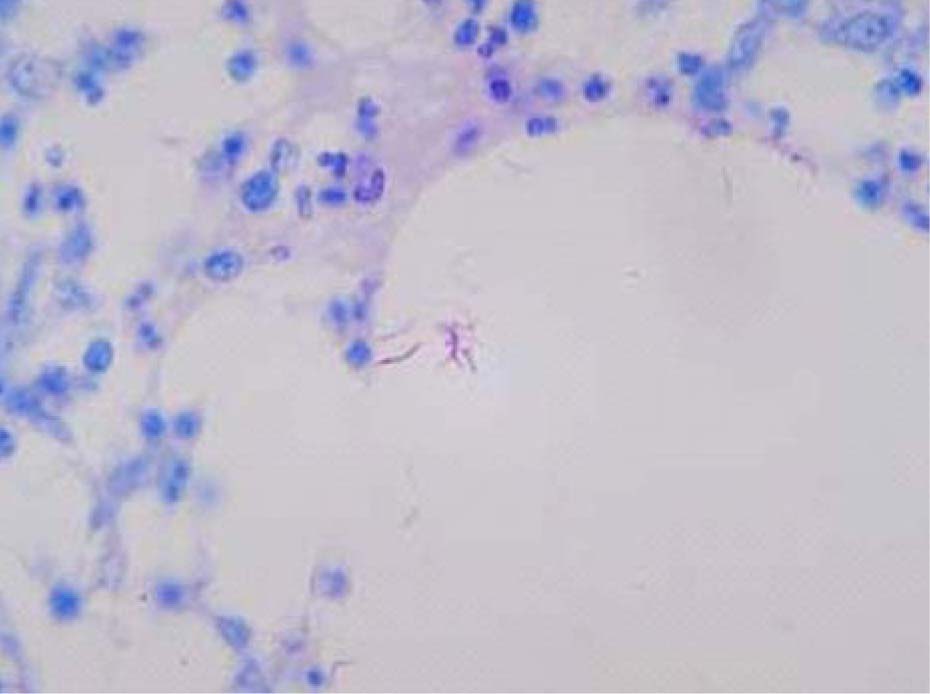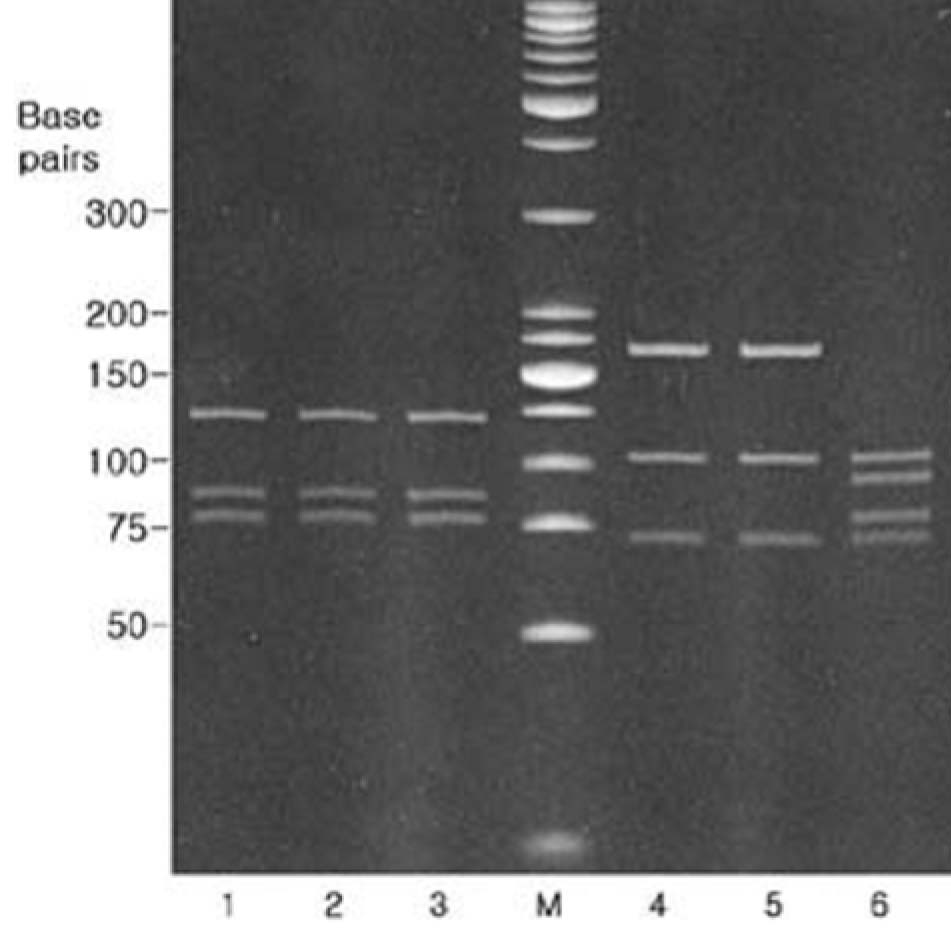Infect Chemother.
2008 Oct;40(5):292-296. 10.3947/ic.2008.40.5.292.
Post-traumatic Infrapatellar Bursitis due to Mycobacterium fortuitum in an Immunocompetent Patient
- Affiliations
-
- 1Department of Internal Medicine, Division of Infectious Disease, Hanyang University College of Medicine, Seoul, Korea. paihj@hanyang.ac.kr
- 2Department of Histopathology, Hanyang University College of Medicine, Seoul, Korea.
- 3Department of Orthopedic Surgery, Hanyang University College of Medicine, Seoul, Korea.
- 4Department of laboratory Medicine, Hanyang University College of Medicine, Seoul, Korea.
- KMID: 2285056
- DOI: http://doi.org/10.3947/ic.2008.40.5.292
Abstract
- Mycobacterium fortuitum is a rare pathogen, frequently found in water, soil, animals and plant materials. It can cause infections involving skin, soft tissue and skeletal system after direct inoculation of the pathogen through surgical traumas, punctures and injections. We report a case of infrapatellar bursitis caused by M. fortuitum in an immunocompetent, 42-year-old female, which occurred after bicycle trauma. She experienced marked improvement after surgical excision and debridement of the wound site and antimicrobial therapy.
MeSH Terms
Figure
Cited by 2 articles
-
Reliability of Sequence-Based Identification of Microorganism
Heungsup Sung, Mi-Na Kim
Infect Chemother. 2008;40(6):355-356. doi: 10.3947/ic.2008.40.6.355.Skin and Soft Tissue Infection due to Rapidly Growing Mycobacteria: Case Series and Literature Review
Jung Re Yu, Sang Taek Heo, Keun Hwa Lee, Jinseok Kim, Jae Kyung Sung, Young Ree Kim, Jae Wang Kim
Infect Chemother. 2013;45(1):85-93. doi: 10.3947/ic.2013.45.1.85.
Reference
-
1. Mandell GL, Bennett JE, Dolin R. Principles and Practice of Infectious Diseases. 2005. 6th. Philadelphia: Churchil Livingstone;2909–2916.2. Goodhart GL. Mycobacterium fortuitum osteomyelitis following trauma. J Orthop Trauma. 1993. 7:142–145.3. Devi DR, Indumathi VA, Indira S, Babu PR, Sridharan D, Belwadi MR. Injection site abscess due to Mycobacterium fortuitum: a case report. Indian J Med Microbiol. 2003. 21:133–134.4. Coney PM, Thrush S. Cutaneous Mycobacterium fortuitum complicating breast reconstruction. J Plast Reconstr Aesthet Surg. 2007. 60:1162–1163.5. Hawkins C, Qi C, Warren J, Stosor V. Catheter-related bloodstream infections caused by rapidly growing nontuberculous mycobacteria: a case series including rare species. Diagn Microbiol Infect Dis. 2008. 61:187–191.
Article6. Silvestre Salvador JF, Betlloch MI, Alfonso R, Ramón RL, Morell AM, Navas J. Disseminated skin infection due to Mycobacterium fortuitum in an immunocompetent patient. J Eur Acad Dermatol Venereol. 1998. 11:158–161.
Article7. Winthrop KL, Abrams M, Yakrus M, Schwartz I, Ely J, Gillies D, Vugia DJ. An outbreak of mycobacterial furunculosis associated with footbaths at a nail salon. N Engl J Med. 2002. 346:1366–1371.
Article8. Park CK, Choi JH, Kim HO, Park CW, Lee CH. A Case of Cutaneous Infection with Mycobacterium fortuitum. Korean J Dermatol. 2007. 45:266–270.9. Park YM, Kang H, Cho SH, Cho BK, Kim BJ, Kook YH, Park EM. A case of scrofuloderma caused by Mycobacterium fortuitum. Korean J Infect Dis. 1999. 31:171–175.10. Lee JH, Moon DC, Kwon KS, Chung TH. A case of mycobacterium fortuitum infection at the site for antibiotics susceptibility test. Korean J Dermatol. 1993. 31:769–774.11. Lee JH, Cha HG, Moon DC, Kwon KS, Chung TA. Mycobacterium fortuitum infection of acupuncture sites. Ann Dermatol. 1994. 6:69–73.
Article12. Kim BJ, Lee KH, Park BN, Kim SJ, Bai GH, Kook YH. Differentiation of mycobacterial species by PCR-restriction analysis of DNA (342 base pairs) of the RNA polymerase gene (rpoB). J Clin Microbiol. 2001. 39:2102–2109.
Article13. Seo YH, Kim W, Ann JY, Keum DG. Identification of Mycobacterium species by Multiplex PCR-Restriction Fragment Length Polymorphism Assay. J Infect Dis. 1999. 31:148–152.14. Brown-Elliott BA, Wallace RJ Jr. Clinical and taxonomic status of pathogenic nonpigmented or latepigmenting rapidly growing mycobacteria. Clin Microbiol Rev. 2002. 15:716–746.
Article15. Rotman DA, Blauvelt A, Kerdel FA. Widespread primary cutaneous infection with Mycobacterium fortuitum. Int J Dermatol. 1993. 32:512–514.
Article16. Rosenmeier GJ, Keeling JH, Grabski WJ, McCollough ML, Solivan GA. Latent cutaneous Mycobacterium fortuitum infection in a healthy man. J Am Acad Dermatol. 1991. 25:898–902.
Article17. Winthrop KL, Albridge K, South D, Albrecht P, Abrams M, Samuel MC, Leonard W, Wagner J, Vugia DJ. The clinical management and outcome of nail salon-acquired Mycobacterium fortuitum skin infection. Clin Infect Dis. 2004. 38:38–44.
Article18. Olson ES, Simpson AJ, Norton AJ, Das SS. ot everything acid fast is Mycobacterium tuberculosis--a case report. J Clin Pathol. 1998. 51:535–536.19. El Amin NM, Hanson HS, Pettersson B, Petrini B, Von Stedingk LV. Identification of non-tuberculous mycobacteria: 16S rRNA gene sequence analysis vs. conventional methods. Scand J Infect Dis. 2000. 32:47–50.
Article20. Brown-Elliott BA, Wallace RJ Jr, Crist CJ, Mann L, Wilson RW. Comparison of in vitro activities of gatifloxacin and ciprofloxacin against four taxa of rapidly growing mycobacteria. Antimicrob Agents Chemother. 2002. 46:3283–3285.
Article21. Wallace RJ Jr, Bedsole G, Sumter G, Sanders CV, Steele LC, Brown BA, Smith J, Graham DR. Activities of ciprofloxacin and ofloxacin against rapidly growing mycobacteria with demonstration of acquired resistance following single-drug therapy. Antimicrob Agents Chemother. 1990. 34:65–70.
Article22. Wallace RJ Jr, Brown BA, Onyi GO. Susceptibilities of Mycobacterium fortuitum biovar. fortuitum and the two subgroups of Mycobacterium chelonae to imipenem, cefmetazole, cefoxitin, and amoxicillin-clavulanic acid. Antimicrob Agents Chemother. 1991. 35:773–775.
Article23. Wallace RJ Jr, Brown-Elliott BA, Ward SC, Crist CJ, Mann LB, Wilson RW. Activities of linezolid against rapidly growing mycobacteria. Antimicrob Agents Chemother. 2001. 45:764–767.
Article
- Full Text Links
- Actions
-
Cited
- CITED
-
- Close
- Share
- Similar articles
-
- Breast Abscess due to Mycobacterium Fortuitum: A Case Report
- Cutaneous Lesion due to Mycobacterium Fortuitum
- Spondylitis with an Epidural Abscess due to Mycobacterium fortuitum: A Case Report
- Mycobacterium fortuitum Infection Associated with Facial Fat Grafting: Simultaneous Infection of Liposuction and Liposculpture Site
- A Case of Cutaneous Infection with Mycobacterium fortuitum



